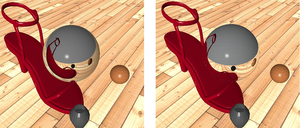Information
- Publication Type: Bachelor Thesis
- Workgroup(s)/Project(s):
- Date: 2013
- Date (Start): 15. March 2012
- Date (End): 6. April 2013
- Matrikelnummer: 0925269
- First Supervisor: Reinhold Preiner
- Keywords: Curved Reflections, Ray-Space Hierarchy, Adaptive Tessellation
Abstract
The rendering of reflections on mirror-like objects is an important operation performed in image synthesis. Being able to calculate the reflections on reflective surfaces in a rendered scene helps visualize many materials which have such properties and aids the viewer in recognizing objects and the perception of distance relations between them. Considering the increasing use of computer systems in day-to-day life, there is much interest in implementing methods that are able to render these reflections at interactive framerates for use in interactive systems, such as computer games and virtual reality. In this paper one given state-of-the-art method and two possible extensions are examined. The method is designed for rendering accurate reflections of geometry on the surface of a curved reflector, utilizing the capabilities of the rendering pipelines implemented on contemporary graphics hardware, in real-time. It is based around finding the reflection point for each vertex of a geometry object, and then letting the graphics hardware rasterize the reflected geometry using the found points. Two important problems with this approach are that the search for the reflection point can take a long time, and that the linear interpolation used in the rasterizing step leads to artifacts on the reflector’s curved surface. The first examined modification is aimed at reducing the time needed for the search of a reflection point by using a hierachial data structure, and an accordingly different searching technique, while still storing the data as efficiently as before. The second modification attempts to reduce the linear interpolation error in the final image by tessellating the reflected geometry. This is done adaptively based on a metric for the error reduced. Finally, some results are presented and discussed and some ideas for possible future work in this field is given.Additional Files and Images
Weblinks
No further information available.BibTeX
@bachelorsthesis{szabo_2013_ssrr,
title = "Rasterized Curved Reflections in Screen Space",
author = "Attila Szabo",
year = "2013",
abstract = "The rendering of reflections on mirror-like objects is an
important operation performed in image synthesis. Being able
to calculate the reflections on reflective surfaces in a
rendered scene helps visualize many materials which have
such properties and aids the viewer in recognizing objects
and the perception of distance relations between them.
Considering the increasing use of computer systems in
day-to-day life, there is much interest in implementing
methods that are able to render these reflections at
interactive framerates for use in interactive systems, such
as computer games and virtual reality. In this paper one
given state-of-the-art method and two possible extensions
are examined. The method is designed for rendering accurate
reflections of geometry on the surface of a curved
reflector, utilizing the capabilities of the rendering
pipelines implemented on contemporary graphics hardware, in
real-time. It is based around finding the reflection point
for each vertex of a geometry object, and then letting the
graphics hardware rasterize the reflected geometry using the
found points. Two important problems with this approach are
that the search for the reflection point can take a long
time, and that the linear interpolation used in the
rasterizing step leads to artifacts on the reflector’s
curved surface. The first examined modification is aimed at
reducing the time needed for the search of a reflection
point by using a hierachial data structure, and an
accordingly different searching technique, while still
storing the data as efficiently as before. The second
modification attempts to reduce the linear interpolation
error in the final image by tessellating the reflected
geometry. This is done adaptively based on a metric for the
error reduced. Finally, some results are presented and
discussed and some ideas for possible future work in this
field is given.",
address = "Favoritenstrasse 9-11/E193-02, A-1040 Vienna, Austria",
school = "Institute of Computer Graphics and Algorithms, Vienna
University of Technology ",
keywords = "Curved Reflections, Ray-Space Hierarchy, Adaptive
Tessellation",
URL = "https://www.cg.tuwien.ac.at/research/publications/2013/szabo_2013_ssrr/",
}

 thesis
thesis

